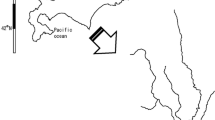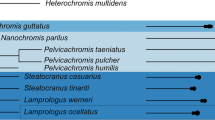Abstract
Numbers of studies in externally fertilizing fish species provide evidence for an effect of ovarian fluid on sperm motility characteristics such as duration of forward mobility, velocity or percent motile sperm cells. Yet, because of variations among females in the quality of their ovarian fluid, such effects might differ between individuals. Additionally, ovarian fluid from different females could also be expected to affect each ejaculate differently, resulting in cryptic female choice. In this study on Artic charr (Salvelnius alpinus), sperm velocity from several males was measured in the diluted ovarian fluid of several females according to a fully balanced crossing design. This design allowed us to estimate variations among females in the effect of their ovarian fluid on the velocity of sperm from different males, and to detect variations among males in the ability of their sperm to swim in ovarian fluid. Sperm velocity was estimated by computer-assisted sperm analysis. Average velocity was found to vary among females, with some females having constantly higher velocity measurements in their ovarian fluid, and among males, indicating that some males had overall faster sperm in ovarian fluid than others. Moreover, variation in sperm velocity was shown to depend on individual female-male interactions. Our results document that females vary in the effect of their ovarian fluid on sperm velocity and that their ovarian fluid may stimulate sperm velocity according to individual characteristics of males. This latter result suggests a potential mechanism for cryptic female choice.

Similar content being viewed by others
Notes
Throughout the literature cited in this study, the terms sperm motility (characteristics) or sperm movement encompass several components of sperm motion such as duration or longevity (i.e. mobility period), percent motile sperm cells and sperm trajectory. Yet the present study focuses only on sperm velocity, i.e. sperm swimming speed.
References
Aas GH, Refstie T, Gjerde B (1991) Evaluation of milt quality of Atlantic salmon. Aquaculture 95:125–132
Andersson M (1994) Sexual selection. Princeton University Press, Princeton
Bakker TCM, Zbinden M (2001) Evolutionary biology—counting on immunity. Nature 414:262–263
Billard R (1988) Artificial insemination and gamete management in fish. Mar Behav Physiol 14:3–21
Billard R, Petit J, Jalavert B, Szöllösi D (1974) Artificial insemination in trout using a sperm diluent. In: Blaxter JH (ed) Early life history of fish. Springer, Berlin Heidelberg New York, pp 715–723
Billard R, Dupont J, Barnabé G (1977) Diminution de la motilité et de la durée de conservation du sperme de Dicentrarchus labrax L. (poisson, téléostéen) pendant la période de spermiation. Aquaculture 11:363–367
Birkhead TR, Pizzari T (2002) Postcopulatory sexual selection. Nat Rev Genet 3:262–273
Bishop JDD (1996) Female control of paternity in the internally fertilizing compound ascidian Diplosoma listerianum.1. Autoradiographic investigation of sperm movements in the female reproductive tract. Proc R Soc Lond Ser B Biol Sci 263:369–376
Breuckmann A, Brucker C (2002) Sperm acrosome antigen-1—specific tissue distribution of immunoreactivity in a teleost fish, the swordtail (Xiphophorus helleri). Cell Tissue Res 308:267–275
Brown JL (1997) A theory of mate choice based on heterozygosity. Behav Ecol 8:60–65
Burness G, Casselman SJ, Schulte-Hostedde AI, Moyes CD, Montgomerie R (2004) Sperm swimming speed and energetics vary with sperm competition risk in bluegill (Lepomis macrochirus). Behav Ecol Sociobiol 56:65–70
Büyükhatipoglu S, Holtz W (1984) Sperm output in rainbow trout (Salmo gairdneri)–effect of age, timing and frequency of stripping and presence of females. Aquaculture 37:63–71
Campbell N (1993) Biology. Cummings
Clark AG, Begun DJ, Prout T (1999) Female x male interactions in Drosophila sperm competition. Science 283:217–220
Eberhard WG (1996) Female control: sexual selection by cryptic female choice. Princeton University Press, Princeton
Elofsson H, Mcallister BG, Kime DE, Mayer I, Borg B (2003a) Long lasting stickleback sperm; is ovarian fluid a key to success in fresh water? J Fish Biol 63:240–253
Elofsson H, Van Look K, Borg B, Mayer I (2003b) Influence of salinity and ovarian fluid on sperm motility in the fifteen-spined stickleback. J Fish Biol 63:1429–1438
Fu P, Neff BD, Gross MR (2001) Tactic-specific success in sperm competition. Proc R Soc Lond Ser B-Biol Sci 268:1105–1112
Gage MJG, Stockley P, Parker GA (1995) Effects of alternative male mating strategies on characteristics of sperm production in the Atlantic salmon (Salmo salar): theoretical and empirical investigations. Philos Trans R Soc Lond Ser B Biol Sci 350:391–399
Hayakawa Y, Munehara H (1998) Fertilization environment of the non-copulating marine sculpin, Hemilepidotus gilberti. Environ Biol Fish 52:181–186
Hoysak DJ, Liley NR (2001) Fertilization dynamics in sockeye salmon and a comparison of sperm from alternative male phenotypes. J Fish Biol 58:1286–1300
Hutter H, Dohr G (1998) HLA expression on immature and mature human germ cells. J Reprod Immunol 38:101–122
Ihaka R, Gentleman R (1996) A language for data analysis and graphics. J Comput Graph Stat 5:299–314
Janeway CA (1993) How the immune system recognizes invaders. Sci Am 269:73–79
Kime DE, Tveiten H (2002) Unusual motility characteristics of sperm of the spotted wolffish. J Fish Biol 61:1549–1559
Kime DE, Ebrahimi M, Nysten K, Roelants I, Rurangwa E, Moore HDM, Ollevier F (1996) Use of computer assisted sperm analysis (CASA) for monitoring the effects of pollution on sperm quality of fish; application to the effects of heavy metals. Aquat Toxicol 36:223–237
Kime DE, Van Look KJW, McAllister BG, Huyskens G, Rurangwa E, Ollevier F (2001) Computer-assisted sperm analysis (CASA) as a tool for monitoring sperm quality in fish. Comp Biochem Physiol C Toxicol Pharmacol 130:425–433
Lahnsteiner F (2000) Morphological, physiological and biochemical parameters characterizing the overripening of rainbow trout eggs. Fish Physiol Biochem 23:107–118
Lahnsteiner F (2002) The influence of ovarian fluid on the gamete physiology in the Salmonidae. Fish Physiol Biochem 27:49–59
Lahnsteiner F, Weismann T, Patzner RA (1995) Composition of the ovarian fluid in 4 salmonid species: Oncorhynchus mykiss, Salmo trutta F lacustris, Salvelinus alpinus and Hucho hucho. Reprod Nutr Dev 35:465–474
Lahnsteiner F, Berger B, Weismann T, Patzner RA (1997) Sperm structure and motility of the freshwater teleost Cottus gobio. J Fish Biol 50:564–574
Lahnsteiner F, Berger B, Weismann T, Patzner RA (1998) Determination of semen quality of the rainbow trout, Oncorhynchus mykiss, by sperm motility, seminal plasma parameters, and spermatozoal metabolism. Aquaculture 163:163–181
Lahnsteiner F, Berger B, Weismann T (1999a) Sperm metabolism of the teleost fishes Chalcalburnus chalcoides and Oncorhynchus mykiss and its relation to motility and viability. J Exp Zool 284:454–465
Lahnsteiner F, Weismann T, Patzner RA (1999b) Physiological and biochemical parameters for egg quality determination in lake trout, Salmo trutta lacustris. Fish Physiol Biochem 20:375–388
Landry C, Garant D, Duchesne P, Bernatchez L (2001) ‘Good genes as heterozygosity’: the Major Histocompatibility Complex and mate choice in Atlantic salmon (Salmo salar). Proc R Soc Lond Ser B Biol Sci 268:1279–1285
Leach B, Montgomerie R (2000) Sperm characteristics associated with different male reproductive tactics in bluegills (Lepomis macrochirus). Behav Ecol Sociobiol 49:31–37
Liley NR, Tamkee P, Tsai R, Hoysak DJ (2002) Fertilization dynamics in rainbow trout (Oncorhynchus mykiss): effect of male age, social experience, and sperm concentration and motility on in vitro fertilization. Can J Fish Aquat Sci 59:144–152
Liljedal S, Folstad I (2003) Milt quality, parasites, and immune function in dominant and subordinate Arctic charr. Can J Zool Rev Can Zool 81:221–227
Liljedal S, Folstad I, Skarstein F (1999) Secondary sex traits, parasites, immunity and ejaculate quality in the Arctic charr. Proc R Soc Lond Ser B Biol Sci 266:1893–1898
Litvak MK, Trippel EA (1998) Sperm motility patterns of Atlantic cod (Gadus morhua) in relation to salinity: effects of ovarian fluid and egg presence. Can J Fish Aquat Sci 55:1871–1877
Macfarlane CP (2002) Gametic interactions in externally fertilising fishes. PhD Thesis, University of Liverpool
Martin-Villa JM, Longas J, Arnaiz-Villena A (1999) Cyclic expression of HLA class I and II molecules on the surface of purified human spermatozoa and their control by serum inhibin B levels. Biol Reprod 61:1381–1386
Mays HL, Hill GE (2004) Choosing mates: good genes versus genes that are a good fit. Trends Ecol Evol 19:554–559
Morisawa M, Suzuki K (1980) Osmolality and potassium-ion: their roles in initiation of sperm motility in teleosts. Science 210:1145–1147
Olsson M, Shine R, Madsen T, Gullberg A, Tegelstrom H (1996) Sperm selection by females. Nature 383:585
Penn DJ, Potts WK (1999) The evolution of mating preferences and Major Histocompatibility Complex genes. Am Nat 153:145–164
Pinheiro JC, Bates DM (2000) Mixed-effects models in S and S-PLUS. Springer, Berlin Heidelberg New York
Reyer HU, Frei G, Som C (1999) Cryptic female choice: frogs reduce clutch size when amplexed by undesired males. Proc R Soc Lond Ser B Biol Sci 266:2101–2107
Rurangwa E, Kime DE, Ollevier F, Nash JP (2004) The measurement of sperm motility and factors affecting sperm quality in cultured fish. Aquaculture 234:1–28
Scofield VL, Schlumpberger JM, West LA, Weissman IL (1982) Protochordate allorecognition is controlled by a MHC-like gene system. Nature 295:499–502
Scott AP, Vermeirssen EM (1994) Production of conjugated steroids by teleost gonads and their role as pheromones. In: Davey KG, Peter RE (eds) Perspectives in comparative endocrinology. S.S. Tobe National Research Council, Ottawa, pp 645–654
Simmons LW, Stockley P, Jackson RL, Parker GA (1996) Sperm competition or sperm selection: no evidence for female influence over paternity in yellow dung flies Scatophaga stercoraria. Behav Ecol Sociobiol 38:199–206
Skarstein F, Folstad I, Grahn M, Liljedal S (2004) MHC and fertilization success in the Arctic charr (Salvelinus alpinus). Behav Ecol Sociobiol (in press)
Stockley P (1997) No evidence of sperm selection by female common shrews. Proc R Soc Lond Ser B Biol Sci 264:1497–1500
Stockley P (1999) Sperm selection and genetic incompatibility: does relatedness of mates affect male success in sperm competition? Proc R Soc Lond Ser B Biol Sci 266:1663–1669
Taborsky M (1998) Sperm competition in fish: “bourgeois” males and parasitic spawning. Trends Ecol Evol 13:222–227
Thornhill R (1983) Cryptic female choice and its implications in the scorpionfly Harpobittacus Nigriceps. Am Nat 122:765–788
Trivers RL (1972) Parental investment and sexual selection. In: Campbell B (ed) Sexual selection and the descent of man 1871–1971. Aldine, Chicago, pp 136–179
Turner E, Montgomerie R (2002) Ovarian fluid enhances sperm movement in Arctic charr. J Fish Biol 60:1570–1579
Vladic TV, Afzelius BA, Bronnikov GE (2002) Sperm quality as reflected through morphology in salmon alternative life histories. Biol Reprod 66:98–105
Wedekind C (1994) Mate choice and maternal selection for specific parasite resistances before, during and after fertilization. Philos Trans R Soc Lond Ser B Biol Sci 346:303–311
Wedekind C, Chapuisat M, Macas E, Rulicke T (1996) Non-random fertilization in mice correlates with the MHC and something else. Heredity 77:400–409
Wilson N, Tubman SC, Eady PE, Robertson GW (1997) Female genotype affects male success in sperm competition. Proc R Soc Lond Ser B Biol Sci 264:1491–1495
Wirtz P (1997) Sperm selection by females. Trends Ecol Evol 12:172–173
Zahavi A (1975) Mate selection—selection for a handicap. J Theor Biol 53:205–214
Ziegler A, Dohr G, Uchanska-Ziegler B (2002) Possible roles for products of polymorphic MHC and linked olfactory receptor genes during selection processes in reproduction. Am J Reprod Immunol 48:34–42
Acknowledgements
We would very much like to thank Nigel Yoccoz for his help with the statistics, and we are grateful to Bob Montgomerie, Ståle Liljedal, Frode Skarstein, Kai Lindström and several anonymous referees for very helpful comments on the manuscript. Ståle Liljedal and Andreas Palmen also put in long hours during fieldwork. The experiment complies with the current Norwegian laws. D.U. is supported by the Swiss National Science Foundation.
Author information
Authors and Affiliations
Corresponding author
Additional information
Communicated by K. Lindström
Rights and permissions
About this article
Cite this article
Urbach, D., Folstad, I. & Rudolfsen, G. Effects of ovarian fluid on sperm velocity in Arctic charr (Salvelinus alpinus). Behav Ecol Sociobiol 57, 438–444 (2005). https://doi.org/10.1007/s00265-004-0876-4
Received:
Revised:
Accepted:
Published:
Issue Date:
DOI: https://doi.org/10.1007/s00265-004-0876-4




